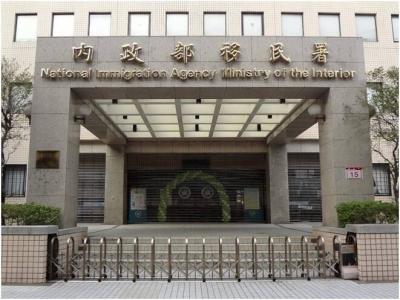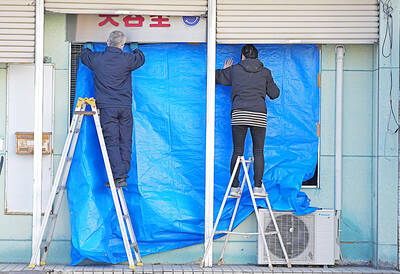Chinese Nationalist Party (KMT) Chairman Eric Chu (朱立倫) today said that Taiwan’s future must not be placed in the hands of Washington or Beijing, as the party marked Double Ten National Day with a flag-raising ceremony outside its headquarters in Taipei.
Chu said in his speech that the Republic of China (ROC) must stand on its own, adding that this is the attitude the nation’s leaders and political parties should have.
Chu, who is to step down as KMT chair after this month’s election, also thanked everyone for their support in transforming the KMT over the past four years.

Photo: Fang Pin-chao, Taipei Times
The six candidates for party chair have the important responsibility of unifying the party and making it stronger, he said.
He said he has faith that the new chair, who is to be elected on Saturday next week and assume the position on Nov. 1, would make the KMT even better.
Speaking to reporters after his speech, Chu responded to President William Lai’s (賴清德) comment yesterday that without Taiwan, there would be no ROC.
Chu said that if Lai was willing to recognize the perspective of the ROC, he would see that the KMT is the ROC’s Nationalist Party, and that many institutions in Taiwan bear the name “China,” referring to the ROC.
However, the Democratic Progressive Party (DPP) has disregarded the ROC, giving the word “China” back to the other side of the Taiwan Strait, insisting there is only Taiwan and turning China into another country, he said.
Whether this was a slip of the tongue or Lai’s true intention, actions are more important than words, he said.
Chu also responded to a leaked draft of Lai’s National Day speech, which mentioned that Taiwan plans to build its own version of the Iron Dome air defense system.
He said that the most widely recognized international strategy is dialogue and deterrence, which means using communication and engagement to reduce risk.
Solely relying on warfare capabilities cannot resolve conflicts, he added.
This is an important year for the ROC, as it marks the 100th anniversary of the passing of the nation’s founder, Sun Yat-sen (孫逸仙), Chu said, adding that he said he hopes everyone would remember Sun’s great deeds.
Chu went on to say that this was a challenging year for Taiwan, as the massive recall campaign against opposition party legislators was the “greatest crisis in Taiwan’s democratic history.”
The DPP has used all available resources and judicial means to suppress and persecute the KMT, he said.
However, the party stood united and defended all its legislators, he said, thanking everyone for safeguarding Taiwan’s democracy.
It has also been a challenging year for Taiwan’s economy, Chu said, adding that the basis for Taiwan’s future development is keeping industries rooted in Taiwan, developing Taiwan and building up the ROC.

A small number of Taiwanese this year lost their citizenship rights after traveling in China and obtaining a one-time Chinese passport to cross the border into Russia, a source said today. The people signed up through Chinese travel agencies for tours of neighboring Russia with companies claiming they could obtain Russian visas and fast-track border clearance, the source said on condition of anonymity. The travelers were actually issued one-time-use Chinese passports, they said. Taiwanese are prohibited from holding a Chinese passport or household registration. If found to have a Chinese ID, they may lose their resident status under Article 9-1

Taiwanese were praised for their composure after a video filmed by Taiwanese tourists capturing the moment a magnitude 7.5 earthquake struck Japan’s Aomori Prefecture went viral on social media. The video shows a hotel room shaking violently amid Monday’s quake, with objects falling to the ground. Two Taiwanese began filming with their mobile phones, while two others held the sides of a TV to prevent it from falling. When the shaking stopped, the pair calmly took down the TV and laid it flat on a tatami mat, the video shows. The video also captured the group talking about the safety of their companions bathing

PROBLEMATIC APP: Citing more than 1,000 fraud cases, the government is taking the app down for a year, but opposition voices are calling it censorship Chinese Nationalist Party (KMT) Chairwoman Cheng Li-wun (鄭麗文) yesterday decried a government plan to suspend access to Chinese social media platform Xiaohongshu (小紅書) for one year as censorship, while the Presidential Office backed the plan. The Ministry of the Interior on Thursday cited security risks and accusations that the Instagram-like app, known as Rednote in English, had figured in more than 1,700 fraud cases since last year. The company, which has about 3 million users in Taiwan, has not yet responded to requests for comment. “Many people online are already asking ‘How to climb over the firewall to access Xiaohongshu,’” Cheng posted on

A classified Pentagon-produced, multiyear assessment — the Overmatch brief — highlighted unreported Chinese capabilities to destroy US military assets and identified US supply chain choke points, painting a disturbing picture of waning US military might, a New York Times editorial published on Monday said. US Secretary of Defense Pete Hegseth’s comments in November last year that “we lose every time” in Pentagon-conducted war games pitting the US against China further highlighted the uncertainty about the US’ capability to intervene in the event of a Chinese invasion of Taiwan. “It shows the Pentagon’s overreliance on expensive, vulnerable weapons as adversaries field cheap, technologically